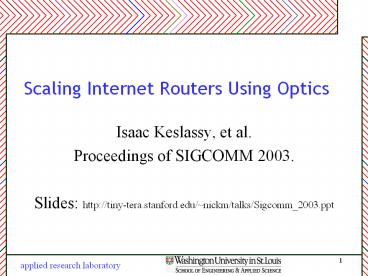Scaling Internet Routers Using Optics - PowerPoint PPT Presentation
1 / 21
Title:
Scaling Internet Routers Using Optics
Description:
Traffic still growing 2x every year. Router capacity growing 2x every 18 months ... mesh carrying twice the capacity (with packets traversing the fabric twice) ... – PowerPoint PPT presentation
Number of Views:25
Avg rating:3.0/5.0
Title: Scaling Internet Routers Using Optics
1
Scaling Internet Routers Using Optics
- Isaac Keslassy, et al.
- Proceedings of SIGCOMM 2003.
- Slides http//tiny-tera.stanford.edu/nickm/talks
/Sigcomm_2003.ppt
2
Do we need faster routers?
- Traffic still growing 2x every year
- Router capacity growing 2x every 18 months
- By 2015, there will be a 16x disparity
- 16 times the number of routers
- 16 times the space
- 256 times the power
- 100 times the cost
- gt Necessity for faster, cost effective, space
and power efficient routers. - Source Dr. Nick McKeowns SIGCOMM talk
3
Current router Juniper T640
- T640 Half-rack
- 37.45 x 17.43 x 31 in (H x W x D)
- 95.12 x 44.27 x 78.74 cms (area 3 m2)
- 32 interface card slots
- 640 Gbps front side switching capacity
- 6500 W power dissipation
- Black body radiation ?T4 W/m2
- at 350 F, Power radiated 2325 W/m2
- Operating temp. 32 to 104 F 0 to 40 C
- ? Stefan Boltzmann constant 5.670 10-8 W /
m2 K4 - References
- http//www.alcatel.com/products/productCollateralL
ist.jhtml?productRepID/x/opgproduct/Alcatel_7670_
RSP.jhtml - http//www.juniper.net/products/ip_infrastructure/
t_series/100051.html03 - http//www.cisco.com/en/US/products/hw/routers/ps1
67/products_data_sheet09186a0080092041.html
4
Multi-rack routers
Switch fabric
Linecards
- Switch fabric and linecards on separate racks
- Problem Switch fabric power density is limiting
- Limit 2.5 Tbps (scheduler, opto-electronic
conversion, other electronics) - Switch fabric can be single stage or multi stage
- Single stage complexity of arbitration
algorithms - Multi-stage unpredictable performance (unknown
throughput guarantees)
5
Optical switch fabric
- Pluses
- huge capacity
- bit rate independent
- low power
- Minuses
- slow to configure (MEMS 10 ms)
- fast switching fabrics based on tunable lasers
are expensive - Reference
- http//www.lightreading.com/document.asp?doc_id22
54sitelightreading
6
Goals
- Identify architectures with predictable
throughput and scalable capacity - Use the load balanced switch described by C-S.
Chang - Find practical solutions to the problems with the
switch when used in a realistic setting - Use optics with negligible power consumption to
build higher capacity single rack switch fabrics
(100 Tbps) - Design a practical 100 Tbps switch with 640
linecards each supporting 160 Gbps
7
Load balanced switch
VOQ
VOQ
VOQ
- 100 throughput for a broad class of traffic
- No scheduler gt scalable
8
Problems with load-balanced switch
- Packets can be mis-sequenced
- Pathological traffic patterns can make throughput
arbitrarily small - Does not work when some of the linecards are not
present or are have failed - Requires two crossbars that are difficult or
expensive to implement using optical switches
9
Linecard block diagram
- Both input and output blocks in one linecard
- Intermediate input block for the second stage in
the load balanced switch
10
Switch reconfigurations
R
R
R
R/N
R/N
R
2R/N
- The crossbars in the load balanced switch can be
replaced with a fixed mesh of N2 links each of
rate R/N - The two meshes can be replaced with a single mesh
carrying twice the capacity (with packets
traversing the fabric twice)
11
Optical switch fabric with AWGRs
AWGR Arrayed Wavelength Grating Router
- AWGR data-rate independent passive optical
device that consumes no power - Each wavelength operates at rate 2R/N
- Reduces the amount of fiber required in the mesh
(N2) - N 64 is feasible but N 640 is not
12
Decomposing the mesh
2R/8
1
1
2
2
3
3
4
4
5
5
6
6
7
7
8
8
Source Dr. Nick McKeowns SIGCOMM slides
13
Decomposing the mesh
2R/8
2R/8
1
1
2R/4
2R/8
2R/8
2
2
3
3
4
4
5
5
6
6
7
7
8
8
Source Dr. Nick McKeowns SIGCOMM slides
14
Full Ordered Frames First (FOFF)
N FIFO queues (one per output)
To intermediate input block
input
- Every N time slots
- Select a queue to serve in round robin order that
holds more than N packets - If no queue has N packets, pick a non-empty queue
in round robin order - Serve this queue for the next N time slots
15
FOFF properties
- No Mis-sequencing
- Bounds the amount of mis-sequencing inside the
switch - Resequencing buffer at most N2 1 packets
- FOFF guarantees 100 throughput for any traffic
pattern - Practical to implement
- Each stage has N queues, first and last stages
hold N21 packets/linecard - Decentralized and does not need complex
scheduling - Priorities are easy to implement using kN queues
at each linecard to support k priority levels
16
Flexible linecard placement
2R/3
- When second linecard fails, links between first
and second linecards have to support a rate of
2R/2 - Switch fabric must be able to interconnect
linecards over a range of rates from 2R/N to R gt
Not practical
17
Partitioned switch
- Theorems
- M LG-1, each path supporting a rate of 2R
- Polynomial time reconfiguration when new
linecards are added or removed.
M input/output channels for each linecard
18
M L G -1 illustration
- Total traffic going out or coming in at Group 1
LR - Total number of linecards L G -1
- Number of extra paths needed to/from first group
L -1
Group 1
Group 1
LC 1
LC 1
LC 2
LC 2
LC L
LC L
Group 2
Group 2
LC 1
LC 1
Group G
Group G
LC 1
LC 1
19
Hybrid electro-optical switch
20
Optical Switch
21
100Tb/s Load-Balanced Router
L 16 160Gb/s linecards
Source Dr. Nick McKeowns SIGCOMM slides































